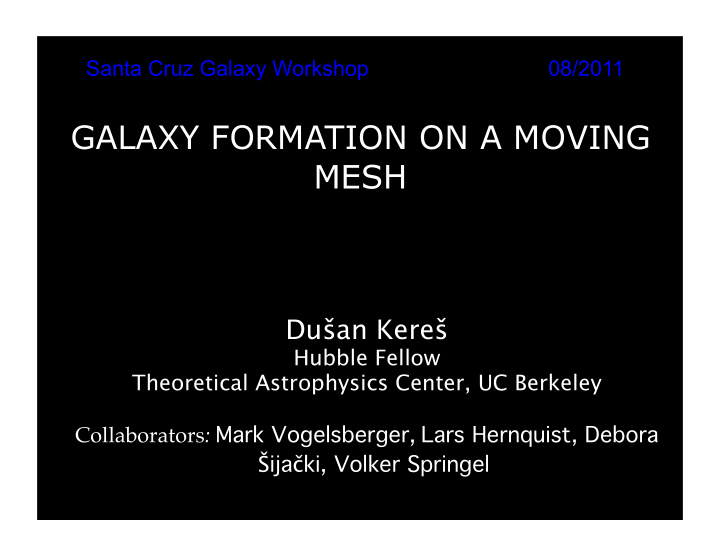



Santa Cruz Galaxy Workshop 08/2011 GALAXY FORMATION ON A MOVING MESH Du š an Kere š Hubble Fellow Theoretical Astrophysics Center, UC Berkeley Collaborators : Mark Vogelsberger, Lars Hernquist, Debora Š ija č ki, Volker Springel
How to reliably simulate galaxies in cosmological environment? • Formation of galaxies requires proper modeling of: – Structure formation – Gas infall into galaxies – Outflows out of galaxies – Interactions of infall/outflows/galaxies with the IGM/CGM • Complex, nonlinear processes, large dynamical range! • Successful codes applied to these problems need to: – Be adaptive to cover huge dynamical range. – Quickly and accurately calculate gravitational interactions. – Properly model hydrodynamics: discontinuities, steep gradients, shocks, instabilities, shear flows etc. • Both SPH and AMR have weaknesses in some of these areas.
Some Strengths & Weaknesses SPH Eulerian-AMR accurate gravity solvers accurate shock solvers (Godunov) • • Galilean invariant resolution of discontinuities • • spatially/temporally adaptive relatively less diffusive • • continuous refinement spatially/temporally adaptive • • flexible geometries large dynamic ranges • • mixing • shocks broadened • discontinuities not well-resolved less accurate gravity solvers • • relatively diffusive (artificial not Galilean invariant • • viscosity) discontinuous refinement • instabilities suppressed • refinement criteria • limited mass resolution • less flexible geometries • mixing suppressed • Mostly complementary attributes
Hybrid approach: moving mesh AREPO (Springel 2010) • Voronoi tessellation of the computational domain • Locations, motion of mesh-generating points arbitrary • AREPO can mimic pure Lagrangian, static mesh & AMR codes • If mesh-generating points move with fluid velocity: Galilean- Invariant • Example: Kelvin-Helmholtz instability on 50 x 50 mesh
From V. Springel
Cosmological simulations with moving mesh and SPH • Moving mesh code AREPO and SPH code GADGET-3. • Start with the same ICs: 20/h Mpc box realized with 2x128^3, 2x256^3, 2x512^3 particles/cells: – Λ CDM cosmology, UV background, primordial cooling curve. – Star formation prescription in pressurized medium of Springel & Hernquist (2003), no outflows from galaxies. – Standard implementations, no parameter change to make results agree. • AREPO is built on GADGET frame: uses the same gravity solver. • AREPO in Lagrangian mode: relatively constant mass in a fluid element, set to be similar to SPH particle mass. – We add refinement and de-refinement, that are only occasionally applied to keep the mass in cell even closer to SPH mass over time.
Results on different scales • AREPO runtimes are only ~1.2-1.5 times slower than GADGET
Extended disks, without ejective feedback... 8
Stellar disks are also more extended 9
Radii of cold galactic gas Gaseous disks of galaxies are systematically more extended in AREPO.
SFR-history After z~3, AREPO runs have higher SFR density. AREPO GADGET
Higher SFRs in massive halos -> efficient hot gas cooling in AREPO -Late time difference in global star formation is caused by massive halos GADGET AREPO Text
Massive halos in AREPO have higher central densities and lower central entropies z=0
What causes the differences? • Sizes and efficient gas cooling in massive galaxies are likely connected. • AREPO: – Extended, das rich disks are easily stripped in hot halos. – Stripped material will not loose angular momentum via dynamical friction like the rest of the infalling substructure (e.g. Maller&Dekel 2002) – It is efficiently mixed with hot gas, enabling more efficient cooling of hot halo. • GADGET: – Harder to strip compact disks with lower gas fractions. – Clumps of gas form via cooling instability and from the stripped material. – These clumps survive too long owing to inability of SPH to properly capture hydro-instabilities (Agertz et al. 2007). – Clumps can heat the surrounding gas and loose angular momentum during the infall. – This process can lower cooling efficiency of the hot gas and cause transfer of angular momentum to the hot gas. • Large differences in energy dissipation of sub-sonic turbulence in the halo infall region and differences in shock capturing create stronger heating of gas at intermediate radii in GADGET.
CONCLUSIONS • AREPO is a very efficient code, suitable for cosmological simulations of galaxy formation. • Gas in centers of hot halos in AREPO cools more efficiently than in the SPH code GADGET. • Specific angular momentum of galactic gas is higher and more aligned in AREPO -> more extended, regular, gaseous disks. • AREPO will likely improve our understanding of important aspects of galaxy and IGM evolution (e.g. disk formation, halo absorbers, hot mode accretion and more).
Transition from cold to hot halos GADGET Text Text AREPO 17
Recommend
More recommend